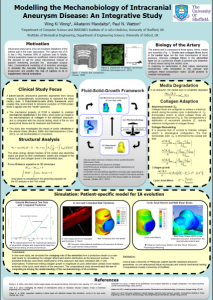Theoretical Mechanobiology Group
Modelling the Evolution of Intracranial Aneurysm Disease – an integrative study
Aneurysm is a ballooning of blood vessel. The thin wall of the balloon increases its likelihood to burst. When it bursts in the brain, one gets a highly fatal stroke. But some of them remain stable and undetectable, without any symptoms. The stable ones are discovered usually when the patient was scanned for some other (possibly) unrelated conditions. Given the low risk of rupture and high risk of surgical procedures, how do we decide whether to monitor or surgically intervene the patient?
An existing model of aneurysm evolution based on the mechanical balance is further improved in my final year project. A stable aneurysm tissue from a patient was measured, to give its tissue thickness and mechanical stress profile. For the first time, this information supplied the model with parameters which has better prediction on how the aneurysm has evolved based on mechanical force balance. This project requires a huge amount of dedication as it is very short (6 months) and exceptional technical skill. Multiple programming languages (Fortran, Perl, MATLAB) were used along with ANSYS CFX, which had been new to me. If it was not immediately obvious, the model was built a while ago, and over these years, it had accumulated sufficient complexity to drown a newbie. Indeed the theory was abstract, hence required creativity and imagination to understand the model.

Fig. 1. BCSWomen Lovelace Colloquium Poster contest finalist
With the project, I had attended two poster sessions, one for BCSWomen Lovelace Colloquium (as a finalist) and one for the INSIGNEO Showcase 2016. Stepping half-a-foot into the academia has once again reassured my desire to at least complete a PhD, because it is simply amazing to feel the enthusiasm other researchers have on their cutting-edge research. Simply mingling with the brightest minds has been a true pleasure.